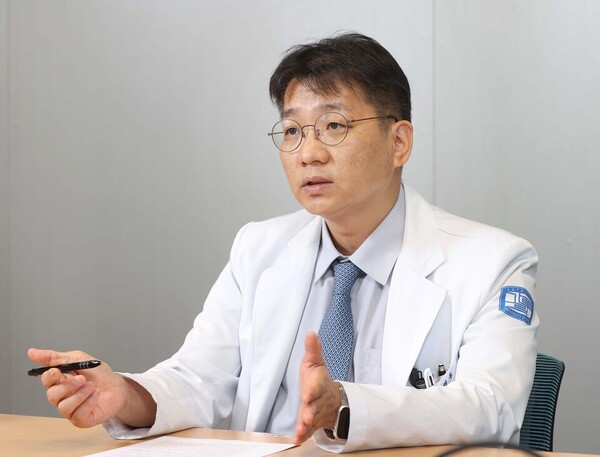The diagnosis of leukemia still strikes fear in many people. Scenes of leukemia patients in movies and TV shows conjure up images of intense chemotherapy and hair loss. However, despite its name, chronic lymphocytic leukemia (CLL) is a very slow-progressing disease that can remain unchanged for the first few years.
One of the rarest cancers in Korea, CLL is caused when B-cell lymphocytes grow and turn cancerous, interfering with the production of normal blood cells. It occurs mostly in older adults and is characterized by repeated relapses and remissions.
Treatments include Bruton tyrosine kinase (BTK) inhibitors. BTK plays a key role in the B cell receptor signaling pathway and is involved in the activation, proliferation, and survival of B cells. BTK inhibitors block this signaling pathway to inhibit the progression of the disease.
In Korea, the first-generation BTK inhibitor Imbruvica (ibrutinib) is prescribed. Recently, the second-generation BTK inhibitor Brukinsa (zanubrutinib) received health insurance coverage, gradually improving the treatment environment for patients.
Korea Biomedical Review interviewed Professor Jeon Young-woo of the Department of Hematology at the Catholic University of Korea Yeouido St. Mary's Hospital to listen to the characteristics and treatment process of chronic lymphocytic leukemia and the clinical significance of the latest drugs.

Question: What is the frequency of chronic lymphocytic leukemia in Korea?
Answer: It is estimated that 150 to 200 patients are diagnosed every year. Overseas, the proportion of older adults over 70 is very high. In Korea, it is more common in the early- to mid-60s. Chronic lymphocytic leukemia, like other blood cancers, often has no clear cause. It develops slowly over months to years, which explains why it can take quite a long time for patients or their families to recognize the disease.
Q: What are the main characteristics of CLL and how are patients diagnosed?
A: There are three main ways in which patients come to the doctor. First, they come to the doctor because of weakness or low energy. It goes beyond the concept of tiredness that most of us feel in the modern world and is so severe that it interferes with daily life, causing people to take time off work or quit. However, it's not easy to diagnose this condition, as the initial blood test to measure white blood cell counts is often normal or slightly elevated.
The second is lymph node enlargement, which is not a characteristic of all patients. Lymph node enlargement is a sign of advanced disease, which can lead to a delay in treatment. The third case is when the patient has no symptoms. In some cases, a patient may be diagnosed with CLL after a comprehensive medical examination and a leukocyte abnormality is detected.
Q: How does treatment for chronic lymphocytic leukemia progress?
A: Even if a diagnosis is made, many don’t start treatment right away. The goal of chemotherapy is to destroy the cancer cells and cure them. Unfortunately, however, unfortunately, CLL is incurable, so current treatment strategies are geared toward keeping people disease-free for as long as possible with a few different drugs.
Another reason for not starting treatment right away after diagnosis is that CLL usually doesn't cause many problems for patients in the early years. “Watch-and-wait” is one of the options considered for treatment. The time to start treatment is when a patient's symptoms worsen, or when they show unusual indicators, such as lymph nodes that more than double in size in a few months. Because of the nature of blood cancers, local treatment is not feasible, and systemic chemotherapy is usually recommended.
Q: What treatments are available to Korean patients, then?
A: In the past, CLL was a typical disease that lacked treatment options even when detected. Cytotoxic anticancer drugs were used when there were no advances in treatment technology, and allogeneic stem cell transplantation was used in cases where treatment did not work well. However, in the last decade, breakthrough therapies have emerged, making the old treatment methods almost obsolete. Previously used treatments had a high burden on patients, such as hair loss and vomiting. Now, however, the paradigm has changed and oral targeted anticancer drugs less toxic than cytotoxic anticancer drugs are being used.
BTK inhibitors, which are typical targeted antitumor drugs, have the mechanism of treating diseases by blocking specific pathways that cancer cells express. They have been continuously developed since the first generation and are now in their third generation. The first-generation BTK inhibitors began to be used in Korean patients five to six years ago, and the second-generation BTK inhibitors have recently been covered by health insurance, increasing the number of good treatment options. I think we are at the point of applying the treatment direction that is in line with the so-called “global standard” to Korean patients.
As second-generation drugs are developed to compensate for the shortcomings of first-generation drugs, patients often consider prescribing second-generation drugs. However, due to the rapid progression of CLL, long-term data is needed to determine the effectiveness, so the outcome of prescribing will have to be observed for a while longer.
Q: What is the safety profile of each generation of BTK inhibitors?
A: Due to the nature of BTK inhibitors, bleeding, decreased heart function, and arrhythmias are possible. When unexpected side effects occur or affect targets other than the intended target, this is known as an off-target effect, and second-generation therapies have improved off-target effects, statistically reducing the incidence of cardiac dysfunction or arrhythmias by half.
To date, a small number of patients have experienced adverse events with first-generation therapies, especially those with severe arrhythmias. They may experience heart palpitations or anxiety every time they take their medication, making it impossible to function. In these cases, the dose is reduced or even stopped altogether. On the other hand, there have been very few adverse cardiac events in patients who have used second-generation drugs for a long time.
As shown by the results of the SEQUOIA study, which looked at the effectiveness and safety of second-generation BTK inhibitors, and the ALPINE study, which compared first- and second-generation drugs, there is a clear difference in safety between first- and second-generation drugs. A limitation of the second generation is that it lacks the long-term accumulated observations of the first generation.

Q: What is the role of third-generation BTK inhibitors like pirtobrutinib, then?
A: The concept of third-generation drugs is a little different from first- and second-generation drugs. They are a last resort for patients who have been treated with first- and second-generation drugs and relapse.
Q: How likely is resistance to BTK inhibitors to occur when prescribed?
A: Resistance is a common reason for the failure of therapies in hematologic cancers. However, BTK inhibitors have a response rate of nearly 80 percent and resistance is less than 20 percent. In such cases, third-generation drugs or other classes of drugs such as BCL-2 inhibitors (venetoclax) may be needed. In terms of resistance, the second generation is thought to be about 10 percent better than the first.
Q: How are generational BTK inhibitors reflected in the Korean and international guidelines?
A: The U.S. NCCN's CLL and small lymphocytic lymphoma (SLL) guidelines recommend second-generation BTK inhibitor therapies, including zanubrutinib monotherapy, acalabrutinib (Calquence in trademark name) monotherapy, or combination therapy with obinutuzumab (Gazyva in trademark name), as preferred regimens in the highest category, or "category 1," for all categories of first-line and second-line or later treatment options.
Ibrutinib, the first BTK inhibitor to emerge, was until recently recommended in the preferred regimens category for first-line and second-line and above. However, with the advent of the second generation, it has unfortunately been pushed down in the rankings and moved to the other recommended regimens category.
In Korea, zanubrutinib began to get insurance coverage on June 1 for the first and second-line treatment of CLL and SLL, which is significant because it is now available to Korean patients in line with international guidelines.
Q: Has the coverage of Brookin's improved the treatment landscape for small lymphocytic lymphoma?
A: SLL is even rarer than CLL, also a rare disease. Because of its small numbers, SLL was not included in the first generation of BTK inhibitors when they got approvals. Patients who should be on BTK inhibitors have used cytotoxic chemotherapy as a second-line option because they were not covered. The coverage of zanubrutinib for SLL is great news for patients.
Other B cell lymphomas, such as mantle cell lymphoma (MCL) and marginal zone lymphoma (MZL), are classified in the same category as CLL, with very similar disease mechanisms and similar treatments. We look forward to seeing BTK inhibitors covered for these diseases, further improving the quality of life for patients.
Q: What is your message to patients?
A: CLL is a rare disease, so when I tell patients the diagnosis, most of them feel like it's a huge blow, and some of them would prepare for sorting their lives. I can understand their feelings because there is still a lack of understanding about CLL. With current medical technology, there is no cure, but the disease can be managed for almost a lifetime with treatment starting at diagnosis. Patients who have been treated for a long time often say that after many years, they feel calm about having a rare lymphoma.
Even if you don't get a cure, you have time to live your life to the fullest, and there are treatments available to help you do that, so stay positive and communicate closely with your doctor. I hope that you will run the marathon and take long breaths with hope, thinking that you will run the road of life with your pacemaker -- your doctor.
Related articles
- Brukinsa gets larger coverage for early-stage monotherapy treatment of MCL, CLL, SLL
- BeiGene's anticancer drug Brukinsa to get expanded insurance coverage
- Based on improved global status, BeiGene targets US market in earnest
- BeiGene applies for insurance benefits for esophageal cancer drug Tevimbra
- Lilly's BTK inhibitor Jaypirca nears approval in Korea for treating mantle cell lymphoma

